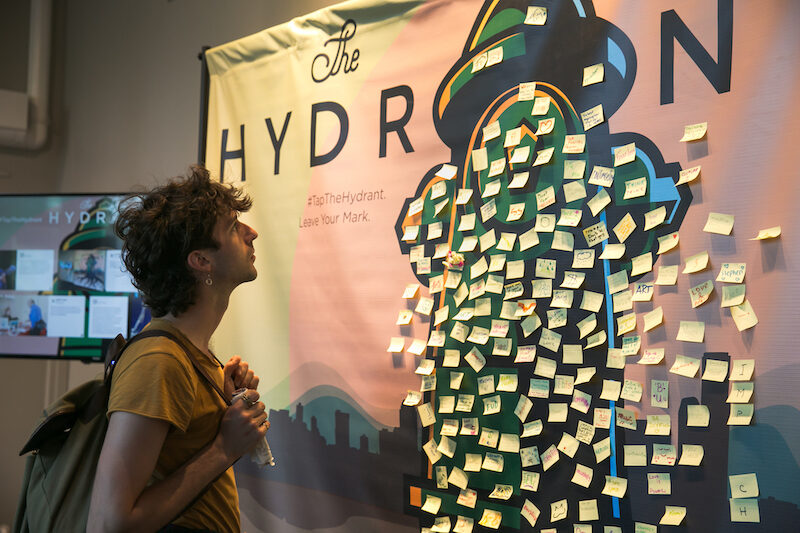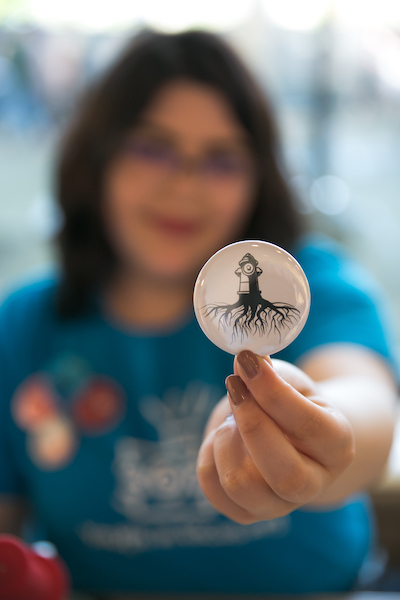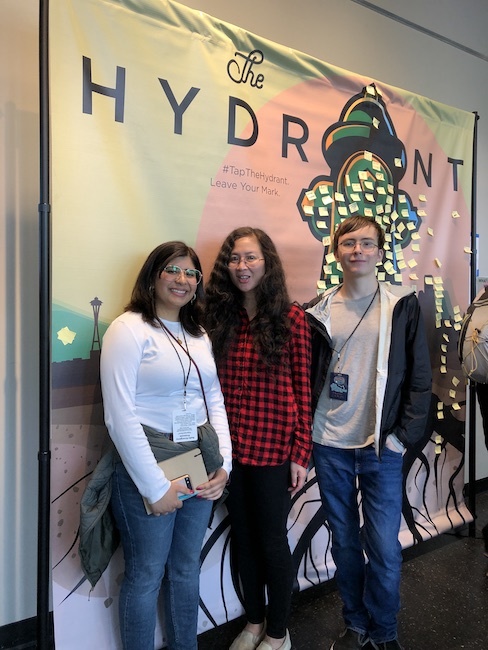The Hydrant Connects Seattle-Area Youth to Arts World
Interview with Nancy Chang and The Hydrant at Northwest Folklife Festival. Written by TeenTix Press Corps writer Nolan DeGarlais.

The 2019 Northwest Folklife Festival featured a new exhibit that put youth arts at the forefront. Fitting with Folklife's 2019 cultural focus of "Youth Rising," the A/NT gallery at Seattle Center featured the showcase of The Hydrant Lounge, a collective of youth arts leaders who came together to promote their work and form lasting partnerships within the art world. With an entrance facing the International Fountain, the central location of The Hydrant Lounge greatly facilitated the Lounge's popularity.
The Hydrant, the organization behind the Folklife display, is a youth-created and youth-led artistic "think tank" that seeks to promote emerging figures in the Seattle arts community. Urging young art creators of all kinds to "tap the Hydrant," the organization gives priority to young creators who, without a platform, may feel isolated in artistic fields that are often dominated by the older generations.
The central theme of the gallery was immediately identifiable upon walking through the doors. A picture of a giant fire hydrant on the wall opposite the main doorway with a small sign next to it invited artists and observers of all ages to write or draw out what "culture" meant to them on a small sticky note, and then to "tap the Hydrant," posting the note on the wall. By the end of the weekend, the wall was filled with a wide array of cultural interpretations, representative of the incredible diversity of Folklife and those involved in the Seattle arts scene.

The Hydrant Lounge featured a wide variety of art displays that centered upon what culture and identity mean to the youth of the Seattle area. One striking display showed skateboards lined up on a wall, all of which were decorated to reveal the deeply-held passions of their owners. Brightly colored and plastered with emotionally evocative imagery, such as heavily-armored police officers discharging firearms, the skateboard display represented cultural values ranging from resistance to police brutality in local communities, to the role these communities play in fostering individual expression.
The Hydrant Lounge also featured showcases of art from various other youth arts programs. Creative Justice, a King County organization that provides arts-based alternatives to incarceration for court-involved King County youth, allows youth to connect with mentors in any arts fields to produce artwork that serves the goal of "building a more just and equitable society."
Their section of the gallery, immediately visible after descending a couple steps to the right of the entrance, prominently featured photos of the young people directly involved in the program. Taken in the style of police-sanctioned mugshots, many of the photographs featured small groups of Creative Justice members standing in front of a mugshot background and holding a placard in the center. However, instead of reading an identification number as one might expect, the placards instead were displayed words such as "free." The pictures thus were representative of the program itself, showing how it works with youth who have encountered trouble with the legal system to help them create their own senses of free expression that can creatively impact society as a whole.
Created by the Folklife Youth Rising Cultural Focus Committee, The Hydrant acts as a cultural hub for youth creators. Nancy Chang, a coordinator of the Hydrant Lounge at the festival, believes that the organization "is an amazing product of what long, ongoing, and institutional Folklife sees as bridging generational gaps."

"Anybody who isn't a Baby Boomer doesn't have [sustainable] power [in the arts community], and those at Folklife have recognized the importance of young people in arts and culture," Chang said. "The Hydrant is a way of showing young people in the Seattle area that adult arts leaders believe that they can help create culture, art, music and community."
While Chang provided insight to the truth that youth have collaborated to make art for decades, she holds The Hydrant up as a model organization for connecting artistic youth in a manner that is far more open and accessible than in her childhood—when young people were often outright told that their contributions did not matter.
"Art and culture are a reflection of who we are, and if young people are not included, that is not [an accurate] representation of society," Chang expressed.
The Hydrant wishes to guide youth to fulfilling artistic expression, regardless of their specific backgrounds in life. Adults working with the program, like Chang, seek to guide young artists into transcending racial, gender, and socioeconomic identities so that all young people can be adequately represented in the Pacific NorthWestern arts community. Chang, who grew up in a community that did not embrace her individual expression, seeks to help today's youth find an outlet for their unique perspectives on life.
"I grew up in a super rural place that was heavily white, and our family was the only Asian family around besides a few Asian adoptees," Chang said. "I was really fortunate to be able to come to Seattle as a young person to Folklife and other events, and just know that there are people who are committed to arts for everybody."
This background led to Chang developing a deep personal relationship with the arts and recognizing their vital importance to the very meaning of human existence.
"Art saves lives," Chang said. "What's the point of life if there's not cool, interesting ideas and experiences?"
The Hydrant and similar youth-based organizations are dedicated to allowing young people to find these meanings and share them with others. While people have always had the option to pursue the arts, Chang hopes that these opportunities will allow youth of all backgrounds to affect change in society, not just those who can be seen as traditional artists.
"I think that the purpose of arts is that bringing joy to society will counteract the generations who lived by the sentiment of o' let's make a lot of money as fast as we can, at any cost,'" Chang said. "When I was younger, art was always seen as being only for 'starving artists' or wealthy people. Now that we are creating better pathways for younger people to see themselves in arts, there will be greater involvement in bringing this joy."
Lead photo credit: Photo by Christopher Nelson, courtesy of Northwest Folklife.
The TeenTix Press Corps promotes critical thinking, communication, and information literacy through criticism and journalism practice for teens. For more information about other Press Corps programs including Press Corps Intensives, the Teen Editorial Staff, or the TeenTix Newsroom, see HERE.


